Xenopus Kazrin interacts with ARVCF-catenin, spectrin and p190B RhoGAP, and modulates RhoA activity and epithelial integrity
- PMID: 21062899
- PMCID: PMC2987443
- DOI: 10.1242/jcs.072041
Xenopus Kazrin interacts with ARVCF-catenin, spectrin and p190B RhoGAP, and modulates RhoA activity and epithelial integrity
Abstract
In common with other p120-catenin subfamily members, Xenopus ARVCF (xARVCF) binds cadherin cytoplasmic domains to enhance cadherin metabolic stability or, when dissociated, modulates Rho-family GTPases. We report here that xARVCF binds and is stabilized by Xenopus KazrinA (xKazrinA), a widely expressed conserved protein that bears little homology to established protein families, and which is known to influence keratinocyte proliferation and differentiation and cytoskeletal activity. Although we found that xKazrinA binds directly to xARVCF, we did not resolve xKazrinA within a larger ternary complex with cadherin, nor did it co-precipitate with core desmosomal components. Instead, screening revealed that xKazrinA binds spectrin, suggesting a potential means by which xKazrinA localizes to cell-cell borders. This was supported by the resolution of a ternary biochemical complex of xARVCF-xKazrinA-xβ2-spectrin and, in vivo, by the finding that ectodermal shedding followed depletion of xKazrin in Xenopus embryos, a phenotype partially rescued with exogenous xARVCF. Cell shedding appeared to be the consequence of RhoA activation, and thereby altered actin organization and cadherin function. Indeed, we also revealed that xKazrinA binds p190B RhoGAP, which was likewise capable of rescuing Kazrin depletion. Finally, xKazrinA was found to associate with δ-catenins and p0071-catenins but not with p120-catenin, suggesting that Kazrin interacts selectively with additional members of the p120-catenin subfamily. Taken together, our study supports the essential role of Kazrin in development, and reveals the biochemical and functional association of KazrinA with ARVCF-catenin, spectrin and p190B RhoGAP.
Figures
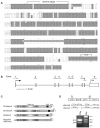
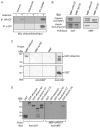

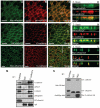
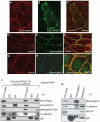

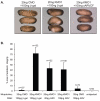
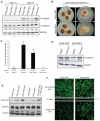
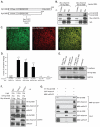


Similar articles
-
Kazrin, and its binding partners ARVCF- and delta-catenin, are required for Xenopus laevis craniofacial development.Dev Dyn. 2011 Dec;240(12):2601-12. doi: 10.1002/dvdy.22721. Epub 2011 Oct 25. Dev Dyn. 2011. PMID: 22028074 Free PMC article.
-
Xarvcf, Xenopus member of the p120 catenin subfamily associating with cadherin juxtamembrane region.J Biol Chem. 2000 Sep 29;275(39):30124-31. doi: 10.1074/jbc.M003048200. J Biol Chem. 2000. PMID: 10899158
-
Vertebrate development requires ARVCF and p120 catenins and their interplay with RhoA and Rac.J Cell Biol. 2004 Apr;165(1):87-98. doi: 10.1083/jcb.200307109. Epub 2004 Apr 5. J Cell Biol. 2004. PMID: 15067024 Free PMC article.
-
Beyond regulation of cell adhesion: local control of RhoA at the cleavage furrow by the p0071 catenin.Cell Cycle. 2007 Jan 15;6(2):122-7. doi: 10.4161/cc.6.2.3741. Epub 2007 Jan 19. Cell Cycle. 2007. PMID: 17264675 Review.
-
The p120 family of cell adhesion molecules.Eur J Cell Biol. 2005 Mar;84(2-3):205-14. doi: 10.1016/j.ejcb.2004.12.016. Eur J Cell Biol. 2005. PMID: 15819401 Review.
Cited by
-
Histone deacetylase 8 interacts with the GTPase SmRho1 in Schistosoma mansoni.PLoS Negl Trop Dis. 2021 Nov 29;15(11):e0009503. doi: 10.1371/journal.pntd.0009503. eCollection 2021 Nov. PLoS Negl Trop Dis. 2021. PMID: 34843489 Free PMC article.
-
Plakophilin-3 catenin associates with the ETV1/ER81 transcription factor to positively modulate gene activity.PLoS One. 2014 Jan 27;9(1):e86784. doi: 10.1371/journal.pone.0086784. eCollection 2014. PLoS One. 2014. PMID: 24475179 Free PMC article.
-
Kazrin promotes dynein/dynactin-dependent traffic from early to recycling endosomes.Elife. 2023 Apr 25;12:e83793. doi: 10.7554/eLife.83793. Elife. 2023. PMID: 37096882 Free PMC article.
-
Kazrin, and its binding partners ARVCF- and delta-catenin, are required for Xenopus laevis craniofacial development.Dev Dyn. 2011 Dec;240(12):2601-12. doi: 10.1002/dvdy.22721. Epub 2011 Oct 25. Dev Dyn. 2011. PMID: 22028074 Free PMC article.
-
p120-catenin regulates REST and CoREST, and modulates mouse embryonic stem cell differentiation.J Cell Sci. 2014 Sep 15;127(Pt 18):4037-51. doi: 10.1242/jcs.151944. Epub 2014 Jul 29. J Cell Sci. 2014. PMID: 25074806 Free PMC article.
References
-
- Aho S., McLean W. H., Li K., Uitto J. (1998). cDNA cloning, mRNA expression, and chromosomal mapping of human and mouse periplakin genes. Genomics 48, 242-247 - PubMed
-
- Anastasiadis P. Z. (2007). p120-ctn: A nexus for contextual signaling via Rho GTPases. Biochim. Biophys. Acta 1773, 34-46 - PubMed
-
- Anastasiadis P. Z., Moon S. Y., Thoreson M. A., Mariner D. J., Crawford H. C., Zheng Y., Reynolds A. B. (2000). Inhibition of RhoA by p120 catenin. Nat. Cell Biol. 2, 637-644 - PubMed
Publication types
MeSH terms
Substances
Grants and funding
LinkOut - more resources
Full Text Sources

